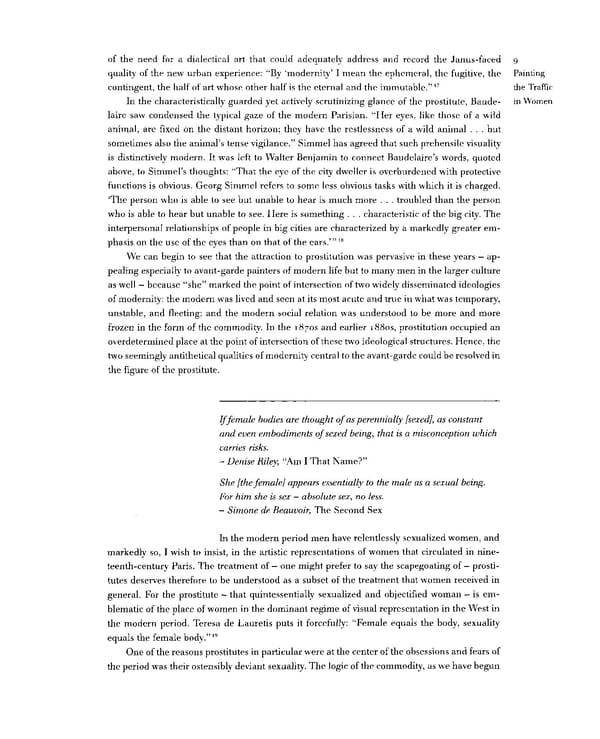of the need for a dialectical art that could adequately address and record the Janus-faced 9 quality of the new urban experience: "By 'modernity' I mean the ephemeral, the fugitive, the Painting contingent, the half of art whose other half is the eternal and the immutable." 17 the Traffic In the characteristically guarded yet actively scrutinizing glance of the prostitute, Baude- in Women laire saw condensed the typical gaze of the modern Parisian. "Her eyes, like those of a wild animal, are fixed on the distant horizon; they have the restlessness of a wild animal . . . but sometimes also the animal's tense vigilance." Simmel has agreed that such prehensile visuality is distinctively modern. It was left to Walter Benjamin to connect Baudelaire's words, quoted above, to Simmel's thoughts: "That the eye of the city dweller is overburdened with protective functions is obvious. Georg Simmel refers to some less obvious tasks with which it is charged. 'The person who is able to see but unable to hear is much more . . . troubled than the person who is able to hear but unable to see. Here is something . . . characteristic of the big city. The interpersonal relationships of people in big cities are characterized by a markedly greater em- 18 phasis on the use of the eyes than on that of the ears.'" We can begin to see that the attraction to prostitution was pervasive in these years — ap- pealing especially to avant-garde painters of modern life but to many men in the larger culture as well — because "she" marked the point of intersection of two widely disseminated ideologies of modernity: the modern was lived and seen at its most acute and true in what was temporary, unstable, and fleeting; and the modern social relation was understood to be more and more frozen in the form of the commodity. In the 18705 and earlier i88os, prostitution occupied an overdetermined place at the point of intersection of these two ideological structures. Hence, the two seemingly antithetical qualities of modernity central to the avant-garde could be resolved in the figure of the prostitute. If female bodies are thought of as perennially [sexed], as constant and even embodiments of sexed being, that is a misconception which carries risks. - Denise Riley, "Am I That Name?" She [the female] appears essentially to the male as a sexual being. For him she is sex - absolute sex, no less. - Simone de Beauvoir, The Second Sex In the modern period men have relentlessly sexualized women, and markedly so, I wish to insist, in the artistic representations of women that circulated in nine- teenth-century Paris. The treatment of — one might prefer to say the scapegoating of — prosti- tutes deserves therefore to be understood as a subset of the treatment that women received in general. For the prostitute — that quintessentially sexualized and objectified woman — is em- blematic of the place of women in the dominant regime of visual representation in the West in the modern period. Teresa de Lauretis puts it forcefully: "Female equals the body, sexuality 19 equals the female body." One of the reasons prostitutes in particular were at the center of the obsessions and fears of the period was their ostensibly deviant sexuality. The logic of the commodity, as we have begun
 Prostitution & Impressionists Page 29 Page 31
Prostitution & Impressionists Page 29 Page 31